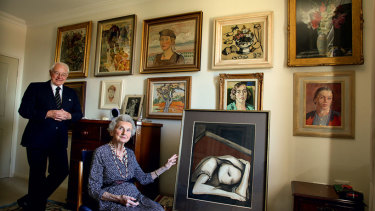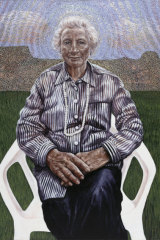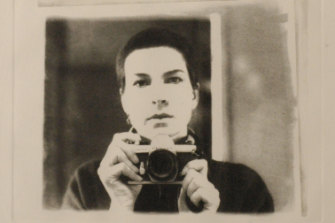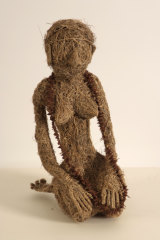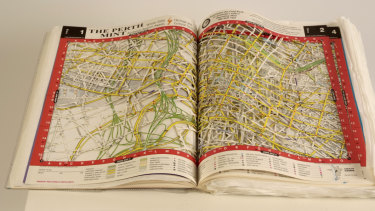The art world angel, her son, the countess and the detective

Sheila Cruthers never finished school, but by the time she died in 2011, aged 86, the former shop girl from regional Western Australia had made a major impact on the lives of women artists.
What began as a hobby in her fifties, visiting galleries with her art-loving teenage son and occasionally buying self-portraits of young women painters, has become a significant legacy for the Australian art world and will change what we see in galleries and museums in this country.
Sheila and Jim Cruthers in their apartment with some of her collection.
Next week her children, John Cruthers and Sue Cruthers, will launch the Sheila Foundation, Australia's first national public foundation, to address gender bias against women artists in Australia, past and present.
John Cruthers believes it will draw women artists back into our history and build on the work of the Cruthers Collection of Women's Art at The University of Western Australia, which already has more than 700 works in its collection and which is worth millions of dollars.
The foundation will do more than just exhibit and care for a bunch of old paintings. It will fund Countess, a project designed to keep a close – statistical – eye on whether women get a fair go in the visual arts, from canvas to boardroom; and it will employ researchers to find our disappeared women.
In a land where our gallery walls are still adorned with the work of male geniuses, the Western Australian philanthropist's strong support for women is making a change.
This is the story of an "angel" who believed in women artists, her son who wants to honour her memory, the countess and a detective.
The angel
Wudjula Yorgah (White Woman), 2005, by Julie Dowling.Credit:Cruthers Collection
Sheila Cruthers is still alive in the memory of our most successful Australian artists. In 1992, Julie Dowling (and her twin) were the first First Nations people to graduate from Curtin University in Western Australia.Sheila was there at the graduate show.
"She made a beeline for me and my twin and we had a big old yarn and that's where it began."
Dowling, whose work is now in every major Australian public collection, remembers Sheila as someone who had very early developed a cultural awareness of Indigenous art, unlike many of her generation.
"She wanted to know why I represented more women in my paintings and I told her about my Warida women [kinship], an old school matriarchy. She was really like an aunty, a sister, really tough on you. A good friend to me."
That intensity of focus is a shared memory of Sheila. Susan Norrie, the recipient of the 2019 Australia Council Visual Arts Award; Australia's representative at the 2007 Venice Biennale; and the winner of the first Moet and Chandon award back in 1987, recalls Sheila as a formidable but generous character, someone who bought work from each of Norrie's exhibitions.
"When Sheila decided she'd back someone, she'd back them all the way. Sheila encouraged me to believe in myself as an artist," says Norrie, whose latest commissioned work, for the Australian War Memorial, will be exhibited later this year.
Yet Sheila's own ambitions were stifled early. Sheila Della-Vedova was the youngest of nine children of two Italian migrants. Her father died when she was four years old and she was sent to stay with family friends. Easily the brightest girl in her primary school, Sheila went to work at 14 to help support her family, even though the school principal had begged her to finish her schooling . But when her son John started taking her to art galleries in the early '70s, she immediately embraced what she saw.
Self portrait – 1/60th of a second, 1981 by Anne Newmarch.Credit:Cruthers Collection
Sheila and John would drive around Perth galleries on Saturday afternoons in their blue Ford Falcon, occasionally accompanied by husband Jim and daughter Sue. Together the mother and son learned about Australian art and started buying the odd painting. Her first serious purchases, the works of two West Australian modernists, Kate O'Connor and Elise Blumann, turned her focus to women's art, self-portraits in particular. Once a hobby, collecting women's art soon became Sheila's full-time occupation.
But in 1983 her husband Jim, a Rupert Murdoch executive, was posted to New York. Sheila made demands on Murdoch: one, she wanted an apartment in midtown; and two, her collection must come with her, on the company dime. That apartment in midtown New York, with sweeping views of Central Park, became a haven for scores of visiting Australian women artists during the Cruthers' time in New York. Norrie remembers the walls were lined with the work of women, including her own.
The son
John Cruthers keeps running into women artists who tell him they stayed with his mum in New York. He says his mother would host lunches for other Australian women and introduce the artists to the well-heeled and influential.
"It was a busy port of call for anyone interested in art," says John, now the chair of the Sheila Foundation and for many years, the curator in charge of the huge Australian collection.
Sheila encouraged me to believe in myself as an artist.
For him, the love and care of the Foundation has been a full-time job on top of other activities: curating, dealing, going to auctions and parenting two sons with his partner Elaine Baker, the inaugural UNESCO Chair in Marine Science at the University of Sydney. The warehouse he and Baker live in is now adorned with some of the work his mother loved. Now his aim is to make sure the Sheila Foundation will carry on his mother's dreams of a more equal art world and to ensure that the foundation will not just care for the women's art of the past, but build the art of the future.
In love with art, initially he was the one who dragged Sheila along to art galleries, insisted they buy work, and learned about art collection at the University of WA (now the collection's home). Together they developed the project, which grew into what his mother called "the artist and her work". With each artist, Sheila would buy a self-portrait and then surround it with other paintings by the artist. This collection is 100 per cent women's work. That's unusual in Australia.
The Countess
"While the quality of women's art is as good as men's art, it doesn't get the same exposure," says Elvis Richardson, an artist, a researcher and PhD graduate who launched the Countess report in 2008 to document the deeply divided world of visual arts in Australia.
She analysed what was exhibited (mostly men), who managed the art world (mostly men), who graduated from art school (mostly women). In 2014, with the support of the Cruthers Art Foundation, she detailed gender representation across the Australian art world, from small artist-run spaces to our major museums. This year the Sheila Foundation takes over as the report's major sponsor.
Granny Bass, 1999, by Joyce Winsley.Credit:Cruthers Collection
The director of Sydney's Museum of Contemporary Art, Elizabeth Ann Macgregor, who will launch the Foundation in Perth on Tuesday, says the work of Countess provides the facts, without emotion. That puts it on the agenda for all Australian institutions.
"It's always been a concern for us [at the MCA] to be honest but we are doing ok. I was actually quite surprised when I saw how bad other institutions were in comparison," says Macgregor.
But in other parts of the art world, the Countess report documents, the share is not so fair. Macgregor is on the Council of Australian Art Museum Directors, recalls a a meeting not so long ago.
"I looked around the table the other day and for the first time, there were two other women. Usually, there might be just one other woman, then she disappears and it's just me again," says Macgregor.
The MCA hosts part of the National, a biennial survey of contemporary Australian art. In 2017, Countess noted women made up 47 per cent of the exhibitors. Two years later, remembering that women make up three-quarters of the visual arts graduates, the 2019 National's artists are 60 per cent female.
"But we must keep the thumbscrews on. Countess has raised consciousness but I don't think the job's done," says Richardson. Women, she says, are still missing.
The detective
Juliette Peers, art curator, PhD in Australian studies, describes herself as an art sleuth, looking for missing women artists. She spends hours and hours rummaging around public gallery store rooms, leafing through dusty catalogues, documents, newspapers and microfilm, scanning biographies for mentions of women who have not yet been acknowledged as professional artists.
John Cruthers was keen to see which women artists had disappeared from the public record and he and his sister Sue are funding Into the Light: Recovering Australia's lost women artists 1870-1960, a project which will take at least two more years to complete for all states and territories. With Peers' forensic investigation and ability to tolerate dust, 431 professional women artists working in NSW between 1870 and 1914 have emerged, the great majority not on the public record.
Among those artists, Peers admits she has favourites: Sydney's Olive On Lee, perhaps the first professional Asian Australian woman artist, who won international awards, showed with the Society of Artists in the 1890s. Yet there is no trace of her or her work, a just a mention as hostess of an 1897 Chinese New Year party. Nor do we see much of Jessie Scarvell, one of the few women of her generation now with a recently acquired cache of works in Sydney's S.H. Ervin Gallery, but barely a catalogue to document her contribution.
Street Directory, 2005 by Rima Zabaneh.Credit:Cruthers Collection
Those catalogues and contributions make women's art visible.
Australia's representative at the 1993 Venice Biennale, Jenny Watson, says Sheila Cruthers understood the complicated ways in which women artists needed help: introductions to other collectors, catalogues, support at midcareer when things might be at a bit of a hiatus. A few years after Watson appeared at the Biennale, Sheila bought one of the artist's self-portraits. As Watson says, even after a big international project, women artists can experience a lull and there was Sheila, ready to support.
Long after her death, she still is.
The Artist and her Work, a show drawn from the Cruthers Collection of Women's Art, focusing on self portraiture, will be at the University of Western Australia's Lawrence Wilson Art gallery until December 7. The Sheila Foundation will be formally launched on May 28.
Artists in the shadows
Among the artists that Juliette Peers is proud to be restoring to view are:
Jessie Scarvell (1862-1950) worked in the style of the Australian Impressionists. She exhibited over 67 paintings at the Art Society of New South Wales between 1892 and 1898, receiving favourable reviews in the press. There is no record of any paintings created after 1898, the year she exhibited in Exhibition of Australian Art at Grafton Gallery, London. She moved to rural Queensland after her marriage in 1901.
Ethel Stephens (1864-1944) worked in both oils and watercolours and at the beginning of her career she painted still lifes, landscapes and portraits, developing a modernist style of coloured printmaking on her return from overseas in 1922. She was the first woman committee member of the Royal Art Society (elected 892) and was a leading figure in the Sydney Society of Women Painters.
Edith Cusack (1865-1937) was a gifted impressionist painter and one of the most ambitious women artists in 1890s-1900s Sydney. She had studied in Paris in the early 1890s and shared a studio in Sydney with her sister Aline, also an exhibiting artist. Edith Cusack's works were often illustrated in the press and in early art catalogues, which did not always happen for women artists. Subjects included Maori and Indigenous subjects, working women, industrial landscapes
Charlotte Davis Picken, also known as Charlie, (birthdate unknown – 1930) painted and also produced art deco pottery. Davis Picken studied in London and Paris and in 1908, she won a prize for women artists at the Franco British Exhibition. She worked for both the Tate Gallery and the Wallace Collection museum in London. Her artwork in the AGNSW, a portrait of Thea Proctor, recalls the fluid style of Jacques Emil Blanche, popular at the time, and is an Edwardian-style portrait.
Olive On Lee (dates unknown) was a young Asian Australian artist in 1890s Sydney who showed occasionally during that decade. In 1893 she won a medal at the Chicago exhibition. She showed with the Society of Artists and also was visible in the press as a guest at their social functions along with Tom Roberts, the Mayor of Sydney and assorted dignitaries. Juliette Peers is yet to find an example of On Lee's work.
Source: Read Full Article
